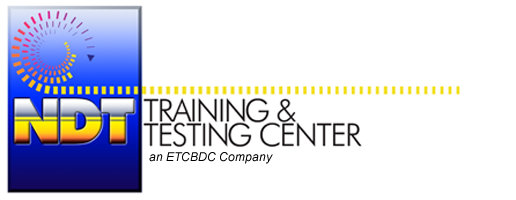Visual Inspection Overview
Our Visual Inspection Courses cover all the information you need to prepare for a career in the NDT Industry!
Visual inspection is basically using your eyes to inspect an item. The purpose of visual inspection is to detect and examine a variety of surface indications or flaws. Therefore, you have options.
- You will do this by looking directly at the surface being inspected.
- Or, you will use a variety of tools to help your ability to see. Mirrors, magnifiers, remote cameras, and other tools are used in inspection situations.
Those indications might include corrosion, surface finish, and surface discontinuities (abnormalities). However, there are other types of indications. Some indications are specific to certain industries or processes. Therefore, special training is required for the inspector.
Visual inspection is important to the quality and safety of materials and structures. Therefore, it is the most widely used method for detecting and examining surface cracks. Indications missed during inspection could cause parts to fail. As a result, material failure could result in collapse, explosion, bodily injury or death.
Your job as an inspector is IMPORTANT! Because, You Keep the World Safe!!
Explore our Visual Inspection Online Course offerings by clicking here
Advantages and Limitations of VT
Our Visual Inspection Course covers both the advantages and disadvantages of the VT Method.
Advantages
- Visual Inspection is fairly inexpensive. Because, Minimal Equipment is required for most applications.
- Training Requirements are easy to achieve
- Minimal Test Object Preparation
- And, VT can be used in conjunction with other NDT Inspection Methods
Limitations
- Detects Surface Discontinuities Only
- Quality of vision and training of inspector determines outcome
- Interpretation of discontinuities is dependent on inspector training and experience with specific codes and standards
Most Common Uses for Visual Inspection
This inspection method is widely used for Dimensional Inspection, Flaw Identification, and Flaw Evaluation. So, let’s take a look at the role of the inspector for each.
Dimensional Inspection is basically measurement. So, in many industries, accurate measurement of components is vital. For example, machining processes require a high degree of accuracy for correct fit and function of parts.
Therefore, accurate dimensional skills are important in manufacturing and design. But, these skills are also important in properly evaluating flaws. Codes and standards are used as guidelines for accepting and rejecting parts. The inspector must be able to correctly use precision measuring tools for some applications.
Flaw Identification and Evaluation skills are applied to a variety of materials. Therefore, a visual inspector must have training to properly identify indications. He or she will also be able to evaluate the indication according to the requirements of appropriate codes and standards. And, as we mentioned, be able to accurately measure and document the indications as well.
A properly trained visual inspector will have training on interpreting Codes and Standards used in industry. As a result, he/she will be better prepared for a variety of inspection situations.
Visual Inspection is in use in a wide variety of industries. So, it is a great career option.
Check out our Online Visual Inspection Course!
These industries include:
- aviation
- automotive
- welding
- manufacturing
- fabrication
- refineries
- pharmaceuticals
- petroleum
- pipeline, and many more.
Therefore, there are many career opportunities available for the trained visual inspector.
Basic VT Techniques
Our Visual Inspection Course covers both direct techniques and indirect techniques.
Direct Inspection
The inspector looks at the object directly. In other words, the inspector is inspecting with his/her eyes only.
Indirect Inspection
In this case, the visual inspector uses a variety of tools to aid in the inspection. Therefore, mirrors, magnifiers, comparators, borescopes and remote cameras are all used in the inspection process. As a result, the inspector has the best chance at correctly identifying and evaluating surface indications.
Visual Inspection Certification Requirements
Our Visual Inspection Course meets the requirements of ASNT NST-TC-1a, NAS-410 and more.
Currently, the American Society for Nondestructive Testing (ASNT) certification requirements are as follows:
- High School Diploma or equivalent
- 24 Hours of Formal Training in VT Method – Classroom, Online, or Hybrid Learning
- Three Tests – General, Specific, and Practical
*General Test – This is a closed book general knowledge test related to the method being studied.
*Specific Test – This test will test your ability to read, interpret and apply work procedures.
*Practical Test – This is a Hands-On test, which will prove your ability to apply what you have learned.
All tests require a minimum score of 70% to pass the test. But, the Composite Score (average of the three) must be a minimum 80%
- On-the-Job Training or Experience – Documented by company
- 70 hours OJT for Level I
- ASNT requires an Additional 140 hours OJT to obtain Level II certification. So, a total of 210 hours of OJT Required
- Annual Vision Acuity and color blindness test
Visual Inspection Training
Visual Inspection requires:
- Basic Math Skills
- Knowledge of correct measuring techniques
- Lighting Techniques
- Flaw Identification
- Code Interpretation, and more
So, for your convenience, we offer Classroom VT Courses, Online NDT Courses, and Hybrid Learning Options.
You may also access full course descriptions and additional information related to Visual Inspection by clicking the links below. As always, you can contact us through the links at the top of the page or by calling 713-849-4006.
Explore our Visual Inspection Online Course offerings by clicking here
Our Visual Inspection Hybrid Learning Options are the BEST VALUE in the industry! So, Click Here to see what it’s all about.
Take a look at or upcoming Visual Inspection Classroom dates by clicking here.

